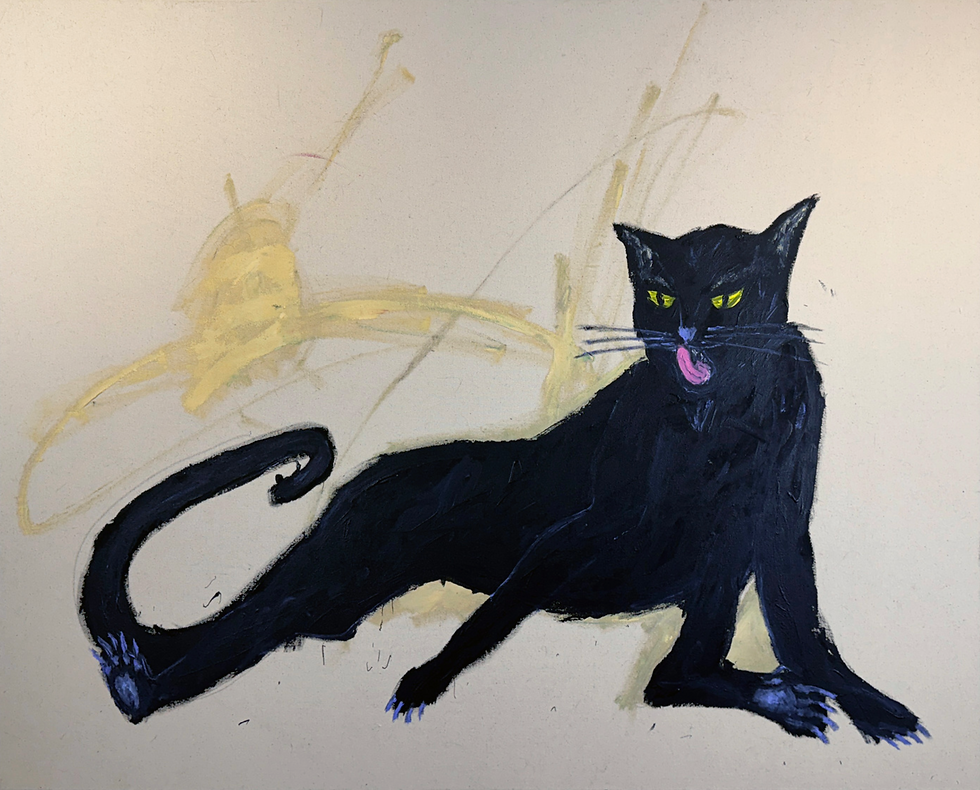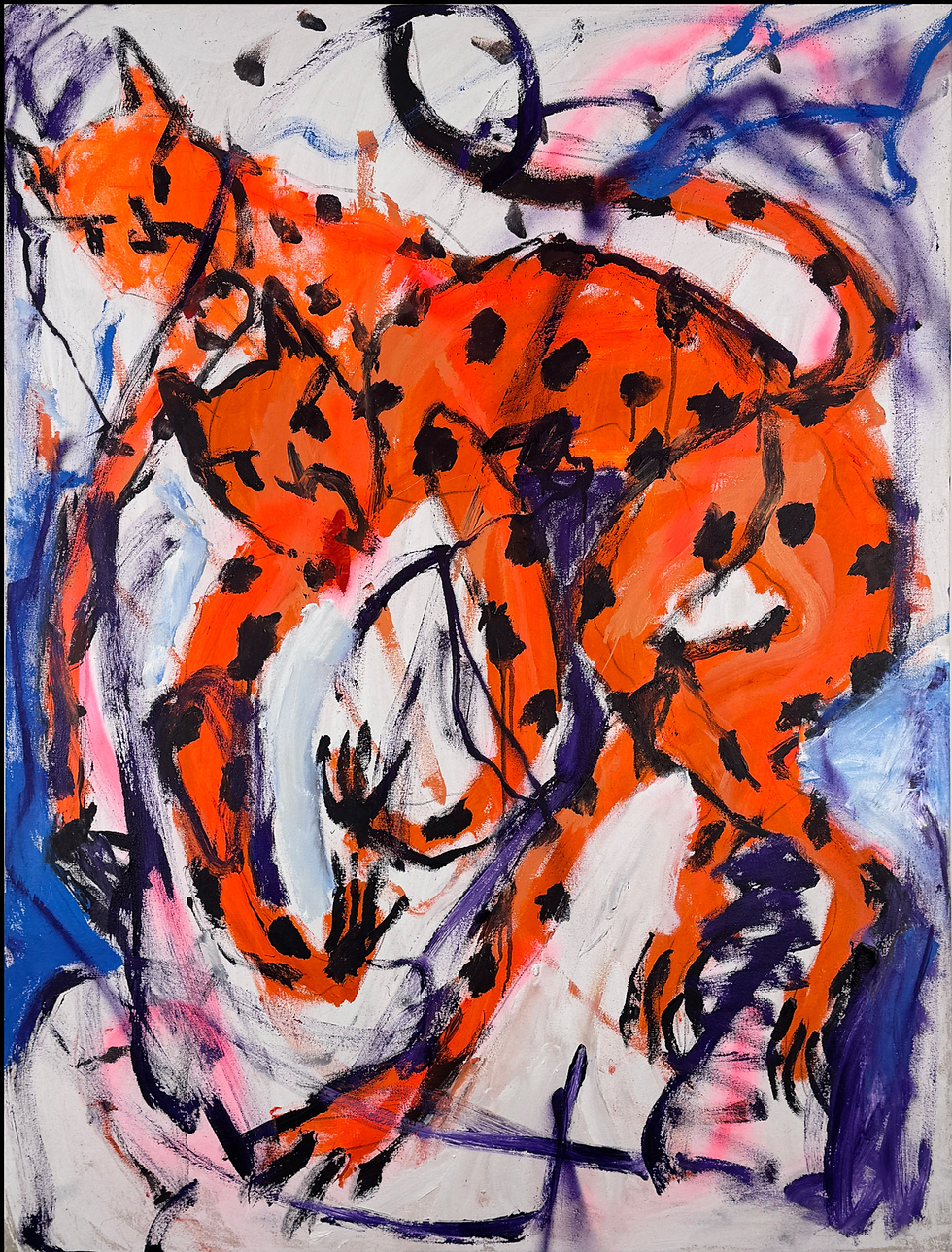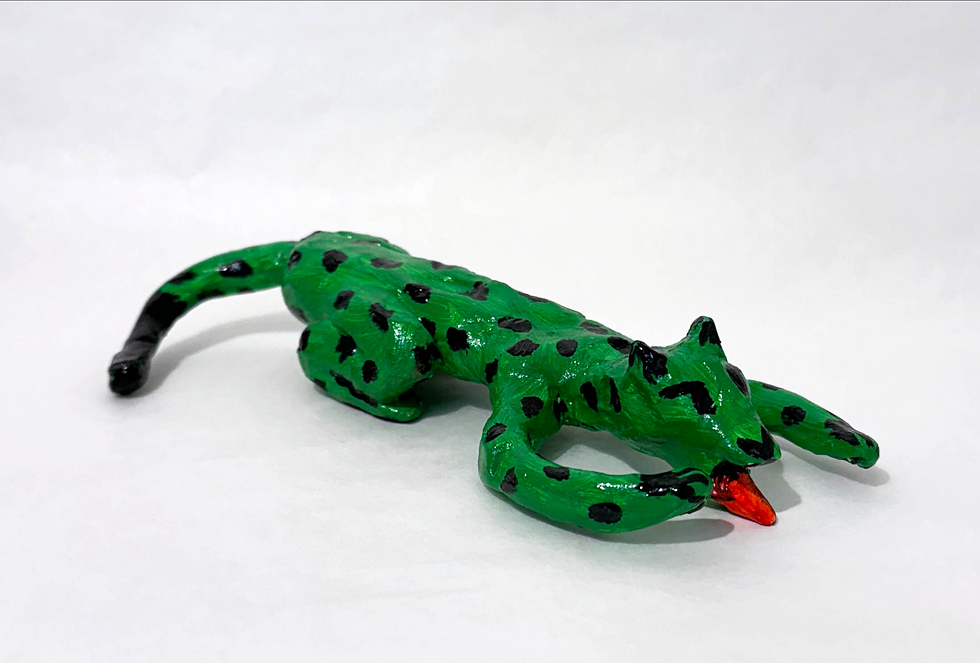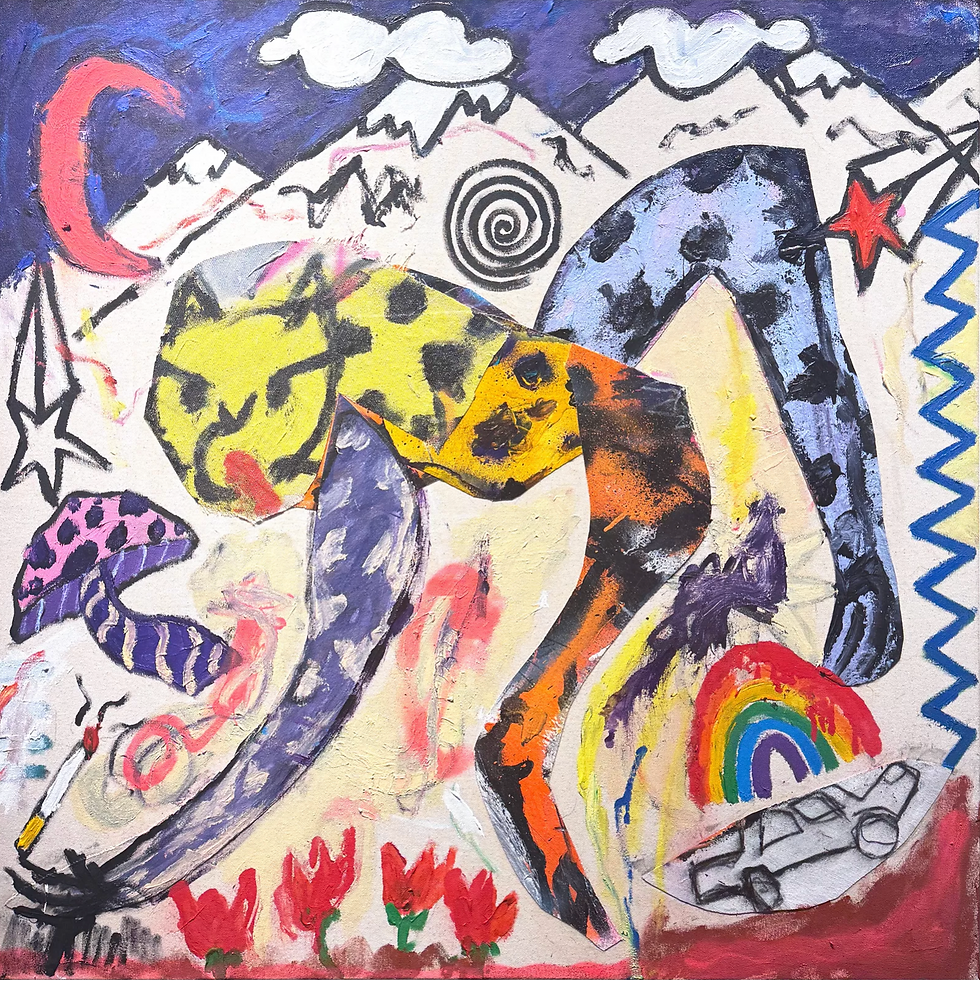Kyle Orlando: “Scratch Fever”
- Eye Level
- Aug 12
- 6 min read
Of cats: their insouciance, their charisma, their curious power over us.

Artists like cats because artists are like cats. The feline temperament is mercurial, ungovernable, mischievous, intermittently social, prone to periods of feverish activity followed by glowering reclusiveness. I’ll wager many painters can relate. Cats are also beautiful animals, moving through the world with a well-curated mixture of adorableness and murderous malice. Phonies they are not. We respect them for their candor.
We respect them so much that we’re often driven to depict them. At the fourth Art Fair 14C, an entire wall of the Jersey City Armory was devoted to cat pictures. It was one of the most popular features of the event for artists and art appreciators alike.
Cat appreciators, too. I don’t know if Kyle Orlando spent any time at that wall, but if he did, he was probably mesmerized. Or perhaps he thought he could do better; either way, those cat paws have a hold of his consciousness, and from the look of his canvases, he’s not fighting it. His cat portraits can be as gnarly as a hairball and as daring as a leap from the top of a refrigerator to the linoleum floor. Orlando’s cats are coming at you, swiping at you from the walls of the gallery with their red tongues hanging out, restless, ornery, impertinent, and impossible to tame. “Scratch Fever,” a solo show at Deep Space Gallery (77 Cornelison St.), is the sort of cat show we might expect to get out of an actual cat — one that bristles and hisses with feral energy and demands to be approached on its own terms only.
Both of the modes in which Orlando operates in “Scratch Fever” ought to be familiar to pet owners and Meow mixers of all kinds. Half of the show is dedicated to semi-realistic portraits of black cats, rendered in acrylic on raw canvases. These customers cross your path with impunity, a regal, don’t-mess-with-me attitude, and facial expressions that waver between surprise and the scorn of a paragon of creation forced to entertain the attentions of members of a species (ours) less evolved.
The other is a spasm of feline energy: animals in unnatural colors and unlikely positions, claws out, haunches up, stretching and lashing out on yarn-tangle backgrounds. In these images, Orlando often presents us with a clutch of cats kneading at the air or pouncing around. This could be a cat-fight in progress, or they could all be the same cat in different positions, moving so fast that we, slowpokes that we are, only perceive them as a blur.

In a three by two grid of tiny canvases, these two styles of cat painting coexist uneasily. Three composed black faces with glowing amber eyes share space with dragon-like creatures in pink, green, and hazmat orange, tongues preceding them, fraying at the edges of their faces, uncomfortably confined within their frames. It is very likely that this is a Jekyll-and-Hyde study of a single feline subject — one moment composed, curious, nearly human, and the next moment an avatar of a savage alien spirit. Cats, as all admirers know, are, from their pointed ears to their pink noses to their saber-toothed mouths, deeply triangular creatures. Orlando’s diagonal lines and sharp edges are barely an exaggeration.
Even in repose, these creatures mean business. In “Talking in the Cinema,” one of the semi-realistic images of a black cat, the subject is splayed out, tail curved, tongue visible and grooming its upper lip. Yet its claws haven’t been retracted, its whiskers are a sextet of blades, and its diagnostic stare is locked on something or someone a few feet in front of the painting. Maybe it’s a mouse. Maybe it’s you.
Much of the tension of “Cinema” comes not from the cat but from a beige shape in the background. It’s a rough arc about the animal’s length, and it’s got a whip-end that mimics the curve of the subject’s tail. These marks look to have been applied to the untreated canvas in a rush: they’re thick and rough, and connected by a golden tether to the cat’s body. It’s possible that Orlando meant to add another shape, or another cat, to the canvas, but it’s for the best that he didn’t. As it is, the rough lines look like strands emanating from the cat’s mind: a visualization of its intentions, a taut scribble, a bowstring drawn back in anticipation of aggressive action.
If “Cinema” is the catapult loaded, “Skunk Cabbage” is the trebuchet released. No line is straight, no color field stays within the boundaries, nothing is relaxed, no quarter is given. Even the spots on the orange cat in the middle of the painting seem to be leaping from its back and into the tangled netherworld that surrounds the animal. A second cat hovers over the shoulder of the first and wags an elongated limb; their back legs are a confusion of curves and angles, and it's hard to tell which paw belongs to which creature. They look like a couple of toughs, taunting and threatening passersby and daring them to rumble.

Like many of the paintings in “Scratch Fever,” “Skunk Cabbage” is substantial: four feet by three feet of pure feline intensity. That’s fifteen hundred square inches of visual happenstance to take in, and there’s turbulence in every corner. Nowhere in the image is a safe place to rest the eye. It’s either electric blue streamers of color bisected by heavy black lines, or smeared fields of stained off-white, or a frazzled cat body that looks to be coming apart. Normally, this would prompt exhaustion. But Kyle Orlando commits to his inquiry so thoroughly that it’s hard for a curious viewer to avoid the catnip he’s dangling. There are entire television programs devoted to understanding cat consciousness. This is his attempt. It looks pretty accurate.
But what about the scaredy cats? Don’t they deserve representation, too? They’re here all right, but in Orlando’s overdriven world, there’s no place to hide. In “Tragic Laughing,” a purple cat with an expression of bewilderment is practically flattened on an orange and white checkerboard. Was it up to something? Has it been caught red-handed, or red-pawed? As is so often the case in Orlando’s feline paintings, there’s a second cat lurking behind the main character. This one is black and white and partial as an x-ray, an imprint of a body, an intimation of that famous cat, beloved by theoretical physicists, who is both there and not there.
It would not be inaccurate to call Kyle Orlando a primitivist. He shares many characteristics with practitioners of the style, including Amelia Shields, another Deep Space favorite whose canvases draw from cartoons and children’s books and who likes to cut to the chase with thick lines and bold tones. His canvases, though, are not childlike. Even when it looks like he's making a mess, he’s always careful to balance his color fields; even when his cat paintings are downright wild, the underlying composition betrays an arts education well absorbed. His paintings succeed for the same reason that classic portraits do: he’s found a visual language that suits the disposition of his characters.

Orlando carries that technique over to Hamilton Park for “My Own Summer” a sister show at Deep Space Special Projects (222 9th Street). Cats stalk this gallery, too, including a clutch of figurines done in the gonzo, multicolored style of his wildest paintings. But in “Summer,” all the subjects — feline and otherwise — are placed in an urban context. And how do Orlando’s animals react to the city? In “Spam Mail,” we’re shown a rainbow, a mountain range, a garden, a hanging star and psychedelic mushroom, an upturned automobile, and more, and looming over all of it and dwarfing it all is a gigantic cat. It’s a titanic representation of the life force at its wildest and a proper object of veneration. Hey, it worked for the ancient Egyptians.
(The twin Kyle Orlando shows will be on view at Deep Space for another few weeks. The gallerists promise there’ll be a closing event, so watch their website and social media. You know how they do it over there. It’s sure to be a swinging party.)




